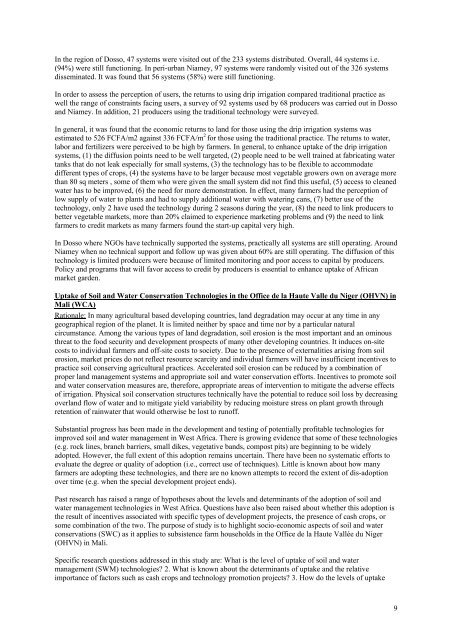ICRISAT Archival Report 2006 - The seedlings of success in the ...
ICRISAT Archival Report 2006 - The seedlings of success in the ...
ICRISAT Archival Report 2006 - The seedlings of success in the ...
You also want an ePaper? Increase the reach of your titles
YUMPU automatically turns print PDFs into web optimized ePapers that Google loves.
In <strong>the</strong> region <strong>of</strong> Dosso, 47 systems were visited out <strong>of</strong> <strong>the</strong> 233 systems distributed. Overall, 44 systems i.e.<br />
(94%) were still function<strong>in</strong>g. In peri-urban Niamey, 97 systems were randomly visited out <strong>of</strong> <strong>the</strong> 326 systems<br />
dissem<strong>in</strong>ated. It was found that 56 systems (58%) were still function<strong>in</strong>g.<br />
In order to assess <strong>the</strong> perception <strong>of</strong> users, <strong>the</strong> returns to us<strong>in</strong>g drip irrigation compared traditional practice as<br />
well <strong>the</strong> range <strong>of</strong> constra<strong>in</strong>ts fac<strong>in</strong>g users, a survey <strong>of</strong> 92 systems used by 68 producers was carried out <strong>in</strong> Dosso<br />
and Niamey. In addition, 21 producers us<strong>in</strong>g <strong>the</strong> traditional technology were surveyed.<br />
In general, it was found that <strong>the</strong> economic returns to land for those us<strong>in</strong>g <strong>the</strong> drip irrigation systems was<br />
estimated to 526 FCFA/m2 aga<strong>in</strong>st 336 FCFA/m 2 for those us<strong>in</strong>g <strong>the</strong> traditional practice. <strong>The</strong> returns to water,<br />
labor and fertilizers were perceived to be high by farmers. In general, to enhance uptake <strong>of</strong> <strong>the</strong> drip irrigation<br />
systems, (1) <strong>the</strong> diffusion po<strong>in</strong>ts need to be well targeted, (2) people need to be well tra<strong>in</strong>ed at fabricat<strong>in</strong>g water<br />
tanks that do not leak especially for small systems, (3) <strong>the</strong> technology has to be flexible to accommodate<br />
different types <strong>of</strong> crops, (4) <strong>the</strong> systems have to be larger because most vegetable growers own on average more<br />
than 80 sq meters , some <strong>of</strong> <strong>the</strong>m who were given <strong>the</strong> small system did not f<strong>in</strong>d this useful, (5) access to cleaned<br />
water has to be improved, (6) <strong>the</strong> need for more demonstration. In effect, many farmers had <strong>the</strong> perception <strong>of</strong><br />
low supply <strong>of</strong> water to plants and had to supply additional water with water<strong>in</strong>g cans, (7) better use <strong>of</strong> <strong>the</strong><br />
technology, only 2 have used <strong>the</strong> technology dur<strong>in</strong>g 2 seasons dur<strong>in</strong>g <strong>the</strong> year, (8) <strong>the</strong> need to l<strong>in</strong>k producers to<br />
better vegetable markets, more than 20% claimed to experience market<strong>in</strong>g problems and (9) <strong>the</strong> need to l<strong>in</strong>k<br />
farmers to credit markets as many farmers found <strong>the</strong> start-up capital very high.<br />
In Dosso where NGOs have technically supported <strong>the</strong> systems, practically all systems are still operat<strong>in</strong>g. Around<br />
Niamey when no technical support and follow up was given about 60% are still operat<strong>in</strong>g. <strong>The</strong> diffusion <strong>of</strong> this<br />
technology is limited producers were because <strong>of</strong> limited monitor<strong>in</strong>g and poor access to capital by producers.<br />
Policy and programs that will favor access to credit by producers is essential to enhance uptake <strong>of</strong> African<br />
market garden.<br />
Uptake <strong>of</strong> Soil and Water Conservation Technologies <strong>in</strong> <strong>the</strong> Office de la Haute Valle du Niger (OHVN) <strong>in</strong><br />
Mali (WCA)<br />
Rationale: In many agricultural based develop<strong>in</strong>g countries, land degradation may occur at any time <strong>in</strong> any<br />
geographical region <strong>of</strong> <strong>the</strong> planet. It is limited nei<strong>the</strong>r by space and time nor by a particular natural<br />
circumstance. Among <strong>the</strong> various types <strong>of</strong> land degradation, soil erosion is <strong>the</strong> most important and an om<strong>in</strong>ous<br />
threat to <strong>the</strong> food security and development prospects <strong>of</strong> many o<strong>the</strong>r develop<strong>in</strong>g countries. It <strong>in</strong>duces on-site<br />
costs to <strong>in</strong>dividual farmers and <strong>of</strong>f-site costs to society. Due to <strong>the</strong> presence <strong>of</strong> externalities aris<strong>in</strong>g from soil<br />
erosion, market prices do not reflect resource scarcity and <strong>in</strong>dividual farmers will have <strong>in</strong>sufficient <strong>in</strong>centives to<br />
practice soil conserv<strong>in</strong>g agricultural practices. Accelerated soil erosion can be reduced by a comb<strong>in</strong>ation <strong>of</strong><br />
proper land management systems and appropriate soil and water conservation efforts. Incentives to promote soil<br />
and water conservation measures are, <strong>the</strong>refore, appropriate areas <strong>of</strong> <strong>in</strong>tervention to mitigate <strong>the</strong> adverse effects<br />
<strong>of</strong> irrigation. Physical soil conservation structures technically have <strong>the</strong> potential to reduce soil loss by decreas<strong>in</strong>g<br />
overland flow <strong>of</strong> water and to mitigate yield variability by reduc<strong>in</strong>g moisture stress on plant growth through<br />
retention <strong>of</strong> ra<strong>in</strong>water that would o<strong>the</strong>rwise be lost to run<strong>of</strong>f.<br />
Substantial progress has been made <strong>in</strong> <strong>the</strong> development and test<strong>in</strong>g <strong>of</strong> potentially pr<strong>of</strong>itable technologies for<br />
improved soil and water management <strong>in</strong> West Africa. <strong>The</strong>re is grow<strong>in</strong>g evidence that some <strong>of</strong> <strong>the</strong>se technologies<br />
(e.g. rock l<strong>in</strong>es, branch barriers, small dikes, vegetative bands, compost pits) are beg<strong>in</strong>n<strong>in</strong>g to be widely<br />
adopted. However, <strong>the</strong> full extent <strong>of</strong> this adoption rema<strong>in</strong>s uncerta<strong>in</strong>. <strong>The</strong>re have been no systematic efforts to<br />
evaluate <strong>the</strong> degree or quality <strong>of</strong> adoption (i.e., correct use <strong>of</strong> techniques). Little is known about how many<br />
farmers are adopt<strong>in</strong>g <strong>the</strong>se technologies, and <strong>the</strong>re are no known attempts to record <strong>the</strong> extent <strong>of</strong> dis-adoption<br />
over time (e.g. when <strong>the</strong> special development project ends).<br />
Past research has raised a range <strong>of</strong> hypo<strong>the</strong>ses about <strong>the</strong> levels and determ<strong>in</strong>ants <strong>of</strong> <strong>the</strong> adoption <strong>of</strong> soil and<br />
water management technologies <strong>in</strong> West Africa. Questions have also been raised about whe<strong>the</strong>r this adoption is<br />
<strong>the</strong> result <strong>of</strong> <strong>in</strong>centives associated with specific types <strong>of</strong> development projects, <strong>the</strong> presence <strong>of</strong> cash crops, or<br />
some comb<strong>in</strong>ation <strong>of</strong> <strong>the</strong> two. <strong>The</strong> purpose <strong>of</strong> study is to highlight socio-economic aspects <strong>of</strong> soil and water<br />
conservations (SWC) as it applies to subsistence farm households <strong>in</strong> <strong>the</strong> Office de la Haute Vallée du Niger<br />
(OHVN) <strong>in</strong> Mali.<br />
Specific research questions addressed <strong>in</strong> this study are: What is <strong>the</strong> level <strong>of</strong> uptake <strong>of</strong> soil and water<br />
management (SWM) technologies? 2. What is known about <strong>the</strong> determ<strong>in</strong>ants <strong>of</strong> uptake and <strong>the</strong> relative<br />
importance <strong>of</strong> factors such as cash crops and technology promotion projects? 3. How do <strong>the</strong> levels <strong>of</strong> uptake<br />
9

















